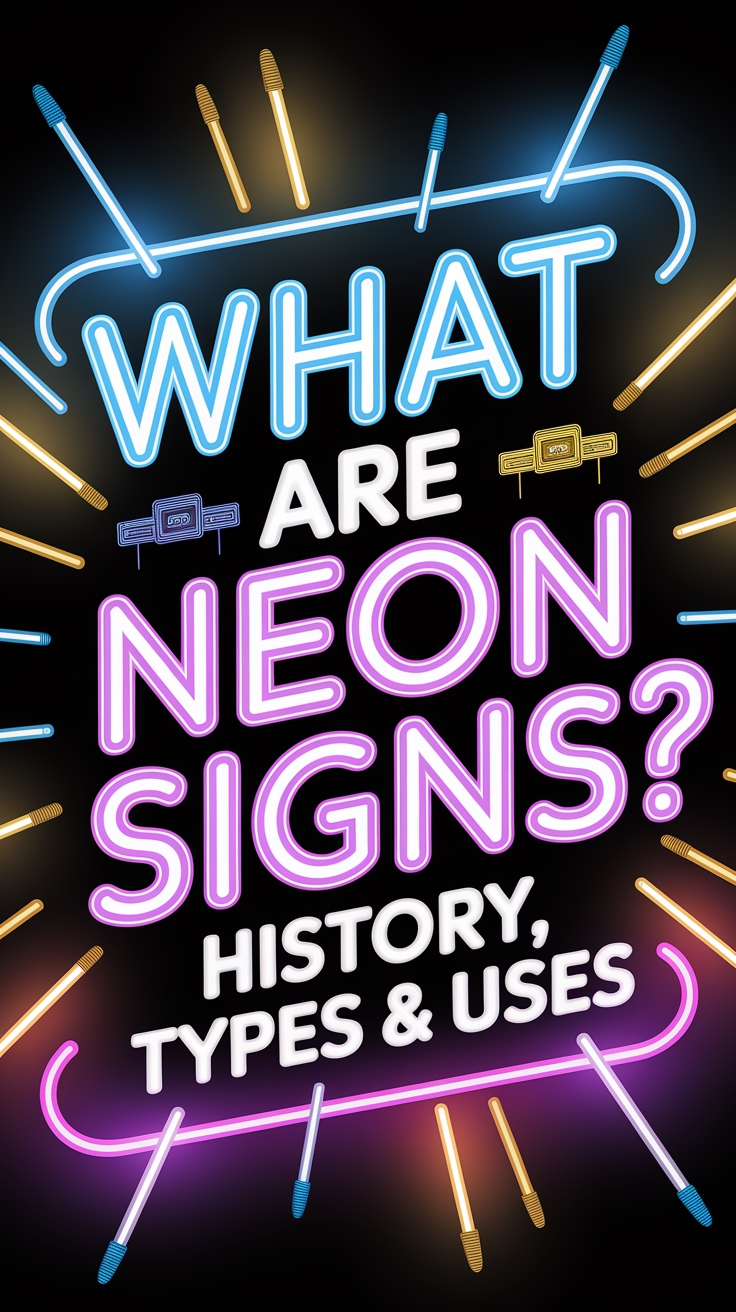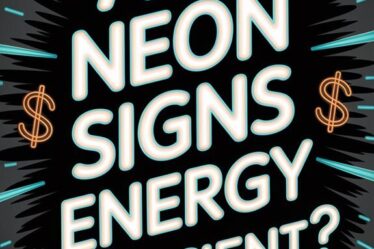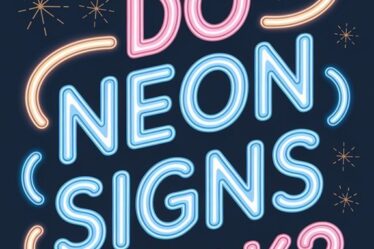
Neon signs combine electrified noble gases in glass tubes or LED alternatives to produce bright, eye-catching displays. These luminous creations have illuminated storefronts, art installations, and decorative spaces since Georges Claude’s 1902 invention. Three main varieties exist: traditional gas-filled tubes, energy-efficient LED strips, and custom designs featuring personalized artwork. Craftsmen shape glass tubes, fill them with gas, and test electrical connections to create these unique pieces of scientific artistry.
Table of Contents
What Are Neon Signs?
Neon signs are illuminated gas-discharge tubes filled with neon or other noble gases that produce vibrant colors when electricity passes through them.
These signs display distinctive colors – pure neon creates red-orange light, while other noble gases produce blue, yellow, and purple hues.
The bright glow occurs when electrons excite gas molecules, releasing photons of light.
These eye-catching displays come in various shapes and sizes, from simple text to intricate animated designs, all powered by high-voltage currents through bent glass tubes.
The Fascinating History of Neon Signs
The discovery of luminous gas tubes in 1902 by Georges Claude launched neon advertising’s remarkable journey.
Neon signs first captured public attention in Paris, 1910, when Claude illuminated the Grand Palais with brilliant, eye-catching tubes.
Types of Neon Signs
When exploring neon signs, you’ll encounter three primary categories: traditional glass tube neon, modern LED neon-style, and custom-designed variations.
Traditional neon signs use noble gases within glass tubes to create that classic warm glow, while LED neon alternatives employ flexible silicone tubes with LED strips to simulate the neon effect.
You’ll find that LED neon signs offer energy efficiency and durability, but traditional neon provides authentic luminescence and artistic craftsmanship that many sign makers and collectors prefer.
Traditional Neon Signs
Classic glass tubes filled with noble gases continue to define traditional neon signs, creating vibrant displays through ionization and electrical current.
Craftsmen carefully bend and shape glass tubing to form these eye-catching signs, which glow in brilliant reds, blues, and pinks. Each tube requires precise heating and gas filling: neon produces red light, while argon mixed with mercury creates blue.
Electrodes power the illumination from both ends, as transformers convert standard voltage to the high levels needed.
Traditional neon signs remain popular in storefronts, theaters, and architectural designs worldwide.
LED Neon Signs
Modern LED neon signs emerged in 2010 as energy-efficient alternatives to traditional glass tube displays, using flexible silicone strips embedded with light-emitting diodes to simulate classic neon’s distinctive glow.
LED neon signs light up everything from store windows to living room walls. Their energy consumption is 80% lower than traditional neon, with a lifespan reaching 50,000 hours.
The LED neon benefits include durability, easy installation, and customizable colors that you can change with remote controls.
These signs operate safely without hazardous gases or high voltage requirements. You can shape them into intricate designs without the risk of breakage often associated with glass tubes.
Custom Neon Signs
Custom neon signs transform businesses and personal spaces through made-to-order designs that incorporate specific text, logos, or artistic elements.
Custom designs range from basic text displays to intricate pictorial artwork, with widths spanning 12 inches to 20 feet.
Personalized messages create distinctive branding solutions for storefronts, restaurants, and bars. You can select from multiple color combinations, fonts, and mounting options to match your exact specifications.
Production typically takes 2-3 weeks, involving precise glass bending and noble gas filling to achieve the desired design.
Comparison of traditional vs. LED neon
Traditional neon signs use noble gases in glass tubes to create vibrant colors through electrical discharge, while LED neon uses flexible strips with light-emitting diodes.
Traditional neon produces authentic, warm glows and seamless curves but needs frequent maintenance.
LED neon delivers longer life, uses 40% less energy and operates for up to 50,000 hours.
LED systems also provide more color choices, better durability, and safer operation without high voltage or breakable glass parts.
How Neon Signs Are Made
The creation of neon signs involves five main stages: glass tube bending, gas evacuation, noble gas filling, electrode installation, and electrical testing.
Craftsmen heat neon glass tubes to 1,500°F using specialized torches, shaping them into custom designs and letters. After cooling, the tubes connect to vacuum pumps for removing impurities and air.
Workers then inject noble gases like neon or argon into the tubes, which produce different colors. After installing electrodes at each tube end, technicians test the electrical connections and transformers to ensure safe, proper illumination before mounting.
Applications of Neon Signs
You’ll find neon signs lighting up commercial spaces across industries, from retail storefronts and restaurants to theaters and nightclubs, serving as powerful advertising tools that capture attention and drive business.
In the artistic domain, neon installations have become increasingly popular in museums, galleries, and public spaces, where they’re used to create immersive experiences and thought-provoking displays.
Beyond advertising and art, neon signs serve practical purposes in wayfinding systems and interior design, helping guide visitors through spaces while adding distinctive ambiance to homes, offices, and entertainment venues.
Commercial Advertising
Since their widespread commercial adoption in the 1920s, neon signs have revolutionized retail advertising by combining eye-catching illumination with distinctive branding potential.
Neon signs enhance brand visibility across commercial settings, from storefronts and restaurants to entertainment venues, drawing customers with vibrant, colorful displays visible at any hour.
In urban environments, neon signs create memorable landmarks and help businesses stand out in crowded marketplaces.
Their versatility allows for custom designs that communicate your brand’s message through shapes, colors, and animated sequences, making them an enduring choice for commercial advertising if you’re looking to capture attention.
Artistic Installations
Modern artists have transformed neon signs into sophisticated gallery installations, museum exhibits, and public art displays across major cultural centers like New York, London, and Tokyo.
Through glowing sculptures and interactive displays, neon art expresses complex themes in multimedia formats. Artists blend neon craftsmanship with digital innovations, creating immersive experiences that challenge perception. Notable examples include Tracey Emin’s handwritten messages and Bruce Nauman’s word-based installations.
Motion sensors, sound elements, and programmable lights enhance audience engagement in these luminous works.
Contemporary neon artists frequently explore social issues, personal narratives, and cultural commentary through their creations.
Decorative Uses
Beyond commercial advertising, neon signs have become popular decorative elements in homes, restaurants, bars, and entertainment venues. These illuminated pieces add warmth and character to interior spaces through their vibrant colors and vintage aesthetics. They shine especially bright in home bars, game rooms, and entertainment areas.
Custom text, abstract designs, and retro imagery transform neon signs into functional art pieces that elevate ordinary spaces.
These versatile installations work equally well as accent lighting, focal points, or conversation pieces across residential and commercial settings.
Directional Signage
Directional signs are critical navigation aids in airports, hospitals, parking facilities, and transit hubs, helping visitors find their way through complex layouts.
Strategically placed illuminated directional signs mark key decision points and intersections. Professional design ensures clear visibility and readability, even in dim lighting conditions.
| Location Type | Common Neon Directions | Typical Colors |
|---|---|---|
| Airports | Gate Numbers, Baggage Claim | Blue, White |
| Hospitals | Emergency, Departments | Red, Green |
| Parking Garages | Exit, Level Numbers | Yellow, Orange |
| Shopping Centers | Store Directory, Restrooms | Purple, Pink |
| Transit Stations | Platform Numbers, Exits | Blue, White |
Advantages and Limitations
While light-emitting diode (LED) technology has gained popularity, traditional neon signs offer distinct advantages that continue to make them valuable for businesses and artistic applications.
Traditional neon signs create an appealing aesthetic with their warm, vibrant glow and handcrafted character. They remain visible from long distances and maintain brightness for 8-15 years.
Still, higher initial costs, increased power use, and glass fragility must be considered.
Environmental concerns include the use of noble gases and mercury in some tubes, though modern manufacturing processes have reduced these impacts.
Regular maintenance, including cleaning and voltage regulator inspections, ensures optimal performance.
Neon vs. LED Neon Technology
As technology continues to evolve, manufacturers have developed two distinct approaches to illuminated signage: traditional glass-filled neon tubes and modern LED strip alternatives.
Classic neon signs illuminate through noble gases and high-voltage electricity, while LED versions utilize light-emitting diodes in flexible strips.
LED technology consumes 70% less energy, lasts over 50,000 hours, and resists damage better than traditional neon. LED neon provides more color choices, programmable effects, and simpler installation.
Traditional neon offers unmatched authenticity and warmth, but LED technology delivers practical benefits for most modern signage needs.
Cultural Impact of Neon Signs
Throughout history, illuminated signage has shaped the visual landscapes of cities and transformed cultural expression across generations. Neon signs illuminate iconic urban spaces, from Times Square and the Las Vegas Strip to Tokyo’s Shibuya district.
Neon nostalgia continues to influence modern art, photography, and design, with vintage-style signs appearing in restaurants, bars, and retail spaces.
These glowing artworks symbolize urban life, modernization, and the allure of nighttime cityscapes. Film directors, musicians, and interior designers use neon elements to create specific moods and capture distinct eras.
Future Trends in Neon Signage
Despite traditional neon’s enduring appeal, modern LED and digital alternatives are reshaping the future of illuminated signage with enhanced efficiency and programmability.
You’ll find sustainable materials transforming neon production, with eco-friendly gases and recycled components reducing environmental impact.
Digital integration lets users control brightness, colors, and animations through mobile apps and cloud platforms.
Smart city projects feature interactive neon displays that respond to weather, traffic, and crowd patterns.
These systems blend classic neon aesthetics with IoT technology to create adaptive advertising that responds to real-time data.
Conclusion
Neon signs have evolved from Georges Claude’s early innovations to today’s modern LED alternatives. These glowing displays continue to transform cityscapes while serving both commercial and artistic purposes. As technology progresses, neon’s impact grows through new applications, maintaining its iconic status in advertising, design, and architecture.



